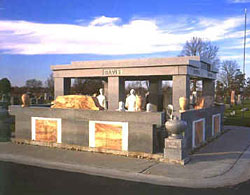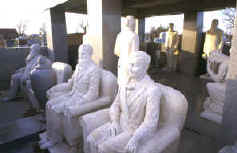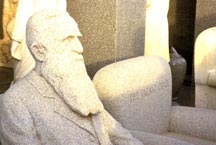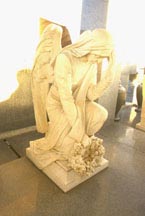 |
| Davis Mausoleum |
Mount Hope Cemetery
Hiawatha, Kansas |
|
 One
of the most fascinating tombs in the United States is in Mount
Hope Cemetery in the sleepy little town of Hiawatha, Kansas. Built
over a period of years in the 1930’s, the Davis Memorial
and its two permanent residents are still the talk of the town. One
of the most fascinating tombs in the United States is in Mount
Hope Cemetery in the sleepy little town of Hiawatha, Kansas. Built
over a period of years in the 1930’s, the Davis Memorial
and its two permanent residents are still the talk of the town.
John Davis was born on January
18, 1855 in Bowling Green, Kentucky. While attending Urania College
in Glasgow, Kentucky he was orphaned. Apparently, he did not have
the means to continue on with college and like many young men
of his time, he wandered west. He worked at various jobs for a
year, before settling in the northeastern Kansas town of Hiawatha
in 1879. Before long he was hired as a farm laborer by a prosperous
local landowner, Tom Hart. Almost immediately, young John Davis
fell in love with and and married the farmer’s daughter,
Sarah. The Hart family was in an uproar over this union and the
newlyweds were unceremoniously cast out and disinherited by the
well-to-do Hart clan. But John and Sarah bought a 260 acre place
of their own, worked hard and spent and invested wisely.
According to a local Hiawatha woman
who knew the Davis' and is still alive today, (1999). "They
had what would be called a traditional marriage for the time.
He was strict, but never beat her. He’d go to work and she’d
stay at home to do the housework. He didn’t want her to even
go into town to do shopping. John would buy the groceries and
bring them home. Sometimes, though, after he left for the day,
she’d go to a neighbor’s place for tea and conversation.
But when someone saw John on the road on the way home, they’d
alert her and she’d scamper back home." After 35 years
of living on the farm, John and Sarah bought and moved into a
Queen Anne style Victorian house in Hiawatha The couple lived
there for a number of years, before Sarah died of a stroke in
1930. Sarah left a simple will that bequeathed her entire estate
to John (they never had any children). When her estate was tallied
up, it totaled over $54,000, including minor items such as $150.00
for "corn in the crib". The will also instructed John
to erect a "suitable memorial" for Sarah at the local
cemetery.
|
|
| |
|
And what a memorial it would be.
Apparently John did purchase and erect a standard grave marker
for Sarah in Mount Hope Cemetery, on the edge of town. But he
wasn’t satisfied with the modest tombstone. So, he conferred
with friend and local monument dealer Horace England and came
up with a plan for the most elaborate and expensive memorial folks
in Hiawatha had ever seen. Some say that Davis had the memorial
built to spite Sarah’s family that had snubbed them so many
year’s before and additionally to spend all of his money
to make sure that none of her relatives would get it after he
died. Others say he built the lavish memorial to Sarah, because
he felt guilty for treating her so badly. And it’s also quite
possible that old John just didn’t know where to stop. The
real truth will never be known. What is true is that the construction
of the memorial created quite a stir in Hiawatha. In the 1930’s,
Hiawatha, like many small farming towns, was affected by the Great
Depression that was gripping the country. Hard cash was in short
supply, and old John Davis was erecting an outrageous memorial
to his dead wife when, according to angry residents of the
town, he should have been helping the living by building a hospital
or helping out his fellow citizens.
|

Eleven statues of John and Sarah Davis at
various stages of their life are housed beneath a granite canopy. |
|
|

Granite statue of John Davis and the "Vacant
Chair" representing Sarah’s absence.
|
Estimates of final cost of the memorial
range from about $200,000 to $500,000 - a tidy sum for the times.
At first, monument dealer Horace England tried to talk Davis out
of his plans. Davis told England that if he didn’t want to
work withhim because of the ill feelings of the townsfolk, although
Davis would understand, he would find another memorial dealer
who would carry out his wishes. England relented and plans were
drawn up for a granite canopy that looks something like a carport.
The canopy, emblazoned with the Davis name, would shelter the
graves of Sarah and John. Also sheltered by the canopy would be
marble statues, carved in Carrera, Italy, of John and Sarah dressed
to the nines commemorating their 50th wedding anniversary. The
statues would be positioned to face their headstones. While this
monumental assembly might be a bit grand by Hiawatha standards,
it’s easy to see why a man with sufficient resources might
want to build a tribute to his wife and their marriage. |
|
|
The canopy and statues were assembled
and erected in 1931. But, John Davis just couldn’t seem to
stop with one pair of statues. "I thought it still looked
too bare, so I got me another pair." Davis said, referring
to the second set of statues he commissioned. The two new additions
depicted John and Sarah in 1890, 10 years after their marriage.
An appropriate gesture, one might say, to bookend their life together.
But not enough for Davis. What followed were a series of additions
to the memorial, which give it a somewhat jumbled look. The final
addition was a granite and marble wall surrounding the memorial
to discourage ("kindly keep off the monument") visitors,
especially children, from playing on the statues.
In early 1932, Davis deeded his
two farms over to English for $31,000 to finance even more statuary.
The third pair, installed that summer, were seated figures of
John and Sarah in 1898. This pair features John Davis clean shaven,
an accurate depiction of him at the time since his flowing beard
had caught on fire in a raging brush fire and he went clean shaven
for a period of time. Now there were six statues. Next in the
series were a depiction of the couple after John suffered a hedge
trimming accident in 1908. Viewers will note that the statue of
John is missing its left hand, a result of the accident. Up to
this point, all of the statues had been carved out of marble.
For the next set, Davis chose granite
because he thought it was better for a man’s features. Sarah
is missing, her absence represented by a vacant chair. For the
final set of figures, Davis returned to marble. Sarah is seen
as an angel kneeling before John’s grave. It is a very interesting
angel. The face does not have the usual young, angelic look. It
is the face of Sarah, wise and worn with the passage of time.
And John’s face? Well, apparently it’s at the bottom
of a local lake. In 1990, vandals beheaded the statue and left
a note saying they had tossed it in a nearby reservoir. A few
years ago the lake was drained, but the head was not found. By
1937 most of the work had been done. It delighted Davis to sit
in his rocking chair underneath a tree near the memorial and watch
the reaction of visitors. Sometimes he would even greet them. |
|
|

Marble statue of Sarah Davis, transformed
into an angel, prays at the grave of John Davis. |
Life Magazine came for a look. Legendary
reporter Ernie Pyle traveled to Hiawatha to interview Davis. As
a final payment for the memorial, 82 year old John Davis deeded
over his house in town to Horace England for one dollar, with
the provision that England would allow Davis to live out his days
there. Later that year, Davis was informed by three doctors that
he had a fatal illness and had less than six months to live. Davis
quickly gave away the last of his fortune (reputed to be about
$55,000) in preparation for his exit from this realm. Either the
doctors miscalculated or Davis summoned up the will to go on,
but he didn’t die in six months. Or six years. He went on
to live another ten years and died absolutely penniless. His friend
and monument dealer, Horace England, was at his side when John
Davis died in his sleep at the Brown County Hillcrest Home, a
place some locals unaffectionately described as "a bug-infested
poor-house".
But, John Davis had had his way.
He built his memorial and and snubbed his nose at the family that
had disinherited him for stealing their daughter many years before.
Nowadays, the Davis memorial is the number one attraction in Hiawatha.
Every year, thousands of visitors come from all over the world
to view this unique tribute, proving that, maybe you can’t
take it with you, but you can certainly leave something behind.
|
|

Guest book at the Davis memorial shows signatures
of guests from as far away as New Zealand, El Salvador, Maine and
California. |
|
|
|
| |